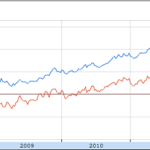Exchange-traded fund investors know better than to ignore the cost of a particular investment in a portfolio. Most gravitate to ETFs for tax efficiency and low annual management fees relative to mutual funds. Let’s explore one natural benefit to the ETF structure that makes it tax efficient.
ETF Structure Affect Tax Liabilities
Exchange-traded funds are designed as trusts, most commonly under the Investment Company Act of 1940, which allows this particular structure of a fund. As a grantor trust, the exchange-traded fund is essentially its own being – an investment company. Buying and selling the ETF, then, is just like buying or selling any other company.
But what makes this open-ended structure unique is the creation and redemption process. Open-ended funds allow for “authorized participants†(mostly major investment banks or hedge funds) to trade assets for new shares, or shares for part of the portfolio’s assets. For example, a hedge fund could offer up a portfolio of S&P500 companies in exchange for shares in the SPDR S&P500 Index ETF (SPY). The hedge fund gives the ETF the appropriate amounts of stock for SPY shares, and the ETF company gives the hedge fund an appropriate amount of SPY shares for their stock.
The opposite of this transaction is the redemption process, whereby investors can trade SPY shares for a large block of all the shares in the S&P500 index.
The Awesome Tax Efficiency of ETFs
This system of creation and redemption allows investors to skip on a majority of their capital gains tax. By virtue of the creation and redemption process, exchange-traded fund administrators can “hide†capital gains that would otherwise be passed on to investors.
Let’s use an example to demonstrate how this works. Suppose State Street Global Advisors, which is the issuer of the popular SPY ETF, has holdings in every stock in the S&P500 index to back its fund. The fund naturally holds some shares at a gain, some at a loss, and from top to bottom the fund has shares acquired at a different cost.
In the S&P500 index is Apple, which SSGA naturally owns in the ETF portfolio. State Street did not acquire all these shares at the same time. It might have two different blocks with a cost basis of $650, and $500, while the current share price might be $600.
In the redemption process, State Street can make redemptions in which it delivers stock in exchange for SPY shares. State Street can deliver the shares with a cost basis of $650 to the investor asking for redemption. This transaction essentially provides for a capital loss of $50 per share, since the current share price is $600, neutering some of the unrealized gains on the stock acquired at a cost basis of $500. Paying out the redemption with shares at a $500 cost basis would create a capital gain of $100, given that the current value of Apple shares is $600 each.
ETFs vs. Mutual Funds on Tax Efficiency
Mutual funds cannot compete with ETFs when it comes to tax efficiency (over virtually anything else – see the data showing Mutual Funds are Dead). Just look to all the stories of mutual funds falling in value yet passing on large capital gains tax bills to investors.
It is tax law that makes ETFs more efficient than mutual funds. Note the difference in tax treatment between the two funds:
- When mutual funds redeem investors’ capital, the transaction is done in cash – shares are sold and the cash is delivered to an investor.
- When ETFs make redemptions, the ETF delivers shares as an exchange. (This is known as an exchange in-kind, where stock in an ETF is exchanged for stock in the underlying assets making up the index.) Exchanging assets is not a taxable event.
The result is that ETFs can essentially “hide†most of their capital gains tax burden, so you can easily calculate your tax refund when the time comes. Mutual funds largely have to pass on this tax burden due to the difference between selling securities and exchanging securities.
ETFs Are Not Perfect!
Exchange-traded funds are not entirely tax-free. Not all of the capital gains in any given ETF can be disposed of via the creation and redemption process. However, because the creation and redemption process is integral to the operation of an open-ended exchange-traded fund, high volumes of creation and redemption do allow for the fund to operate without passing on any capital gains tax directly.
A Bloomberg study made obvious the extreme differences in capital gains taxation between exchange-traded fund structures and mutual fund structures. The study found that in the period of August 2000-2001, exchange-traded funds based on popular indexes passed on an average capital gains tax burden of 0.31% of the ETF’s value compared to 5.87% for mutual funds.
Remember, these are the exact same funds tracking the exact same indexes. The only difference is the structure and tax consequences of selling stock compared to exchanging stock.
In this case, a $100,000 investment spread evenly in every index would result in only $310 in capital gains distributions for the year 2000-2001. Mutual funds, by contrast, passed on capital gains distributions of $5,870.
There are many misconceptions about what ETFs are designed to do and what they deliver. For instance, all leveraged ETFs go to zero and investors are perennially frustrated when they think a 3X ETF should actually triple the return of an index (which they don’t over time!).
Disclosure: the author does not hold any of the securities listed in the article above.










{ 0 comments… add one now }